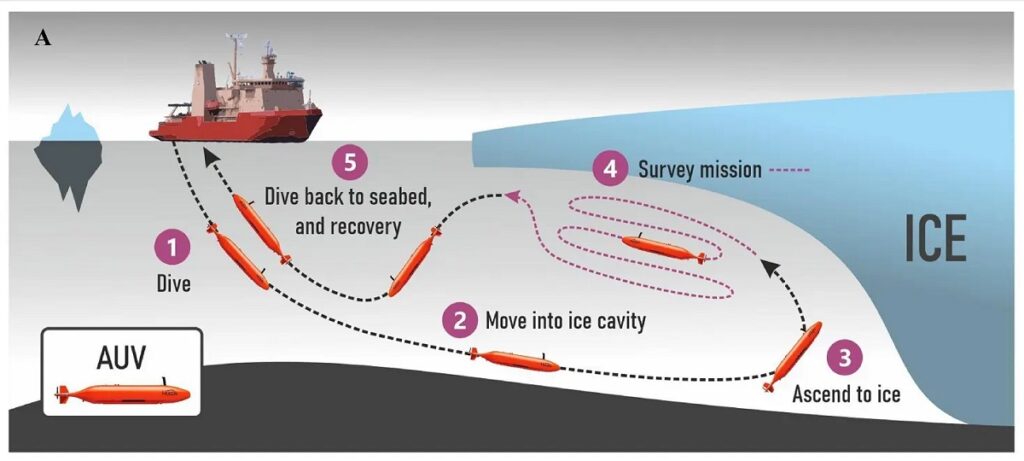In a remarkable scientific achievement, an international research team from the University of Gothenburg deployed an autonomous submarine called Ran beneath the thick ice of Antarctica, uncovering the first detailed maps of the underside of a glacier. These findings are crucial in understanding the future rise in sea levels. But the story didn’t end with the success of their mission—when the team returned in 2024, they found the submarine disappeared without a trace beneath the ice, leaving both the team and the world with more questions than answers.
Delving Into the Mysteries of Antarctica with the Ran Submarine
The Ran submarine was specifically designed to explore the Dotson Glacier cavity in West Antarctica, one of the most challenging and unexplored regions on the planet. Equipped with an advanced sonar system, it ventured under the thick glacier ice for 27 days, traveling more than 1,000 kilometers to map the area. The submersible journeyed up to 17 kilometers into the glacier cavity, gathering unprecedented data about this hidden part of the world.
As Anna Wåhlin, professor of oceanography at the University of Gothenburg and lead author of the study, explained, navigating the submarine through this icy expanse felt like peering into an entirely unknown world. She likened it to seeing the “dark side of the moon”, an analogy that underscores just how groundbreaking these observations were. For decades, the underside of glaciers has remained invisible to scientists, making these discoveries even more valuable.
Key Discoveries Beneath the Glacier
One of the most significant findings of the mission was the ability to measure currents under the glacier for the first time. This data helped researchers understand why the western part of the Dotson ice shelf is melting so rapidly. They also observed remarkably high melt rates along vertical fractures that crisscross the glacier, indicating the dynamic and complex nature of the ice’s interaction with the ocean below.
The submarine also uncovered surprising features at the base of the glacier, including peaks and valleys, plateaus, and formations that resembled sand dunes. The researchers speculate that these landforms could be shaped by moving water, influenced by the Earth’s rotation, adding an intriguing layer to our understanding of glacier dynamics.
New Models and Questions Raised by Ran’s Discoveries
The discoveries made by the Ran submarine are changing how scientists view ice shelves and glaciers. One of the unexpected outcomes was the discovery of unusual patterns at the base of the glacier that current models of glaciology couldn’t fully explain. The patterns, shaped by ice and water movement, have sparked new questions about how glacier formations interact with their environments, challenging existing theories.
Karen Alley, a glaciologist at the University of Manitoba and co-author of the study, emphasized that these maps have vastly improved our understanding of the foundations of Antarctic ice shelves. The new visual data from the Ran submarine helps to calibrate and enhance the satellite images we rely on for monitoring these remote regions from space.
Implications for Glacier Modeling

While the newly collected data has reshaped some of the concepts around ice shelf behavior, it’s clear that the existing models still fall short of explaining the complex features found under the Dotson Glacier. Anna Wåhlin pointed out that this technique—directly exploring the glacier from below—could be the key to developing more accurate predictions of how ice shelves will behave in the future, which is crucial for understanding their contribution to sea level rise.
The data collected by Ran gives scientists a much clearer view of what is happening beneath the Antarctic ice, providing insight into the forces that govern the speed of ice sheet melting. As researchers work to incorporate these new findings into predictive models, we move closer to understanding how the Antarctic ice shelves might change in the coming decades, and the subsequent impact on global sea levels.
Looking Ahead: What’s Next for Antarctic Research?
The mystery of Ran’s disappearance only adds to the intrigue of this mission. As the research continues, these new insights from beneath the ice will undoubtedly play a central role in shaping future climate models. The missing submarine may have vanished into the ice, but the knowledge it helped uncover could pave the way for new technologies and techniques to monitor our planet’s changing ice sheets.
In the end, the hidden face of Antarctica has begun to reveal its secrets, and these discoveries are setting the stage for a deeper understanding of how our planet’s ice and oceans interact—a question that will shape climate science for years to come.






